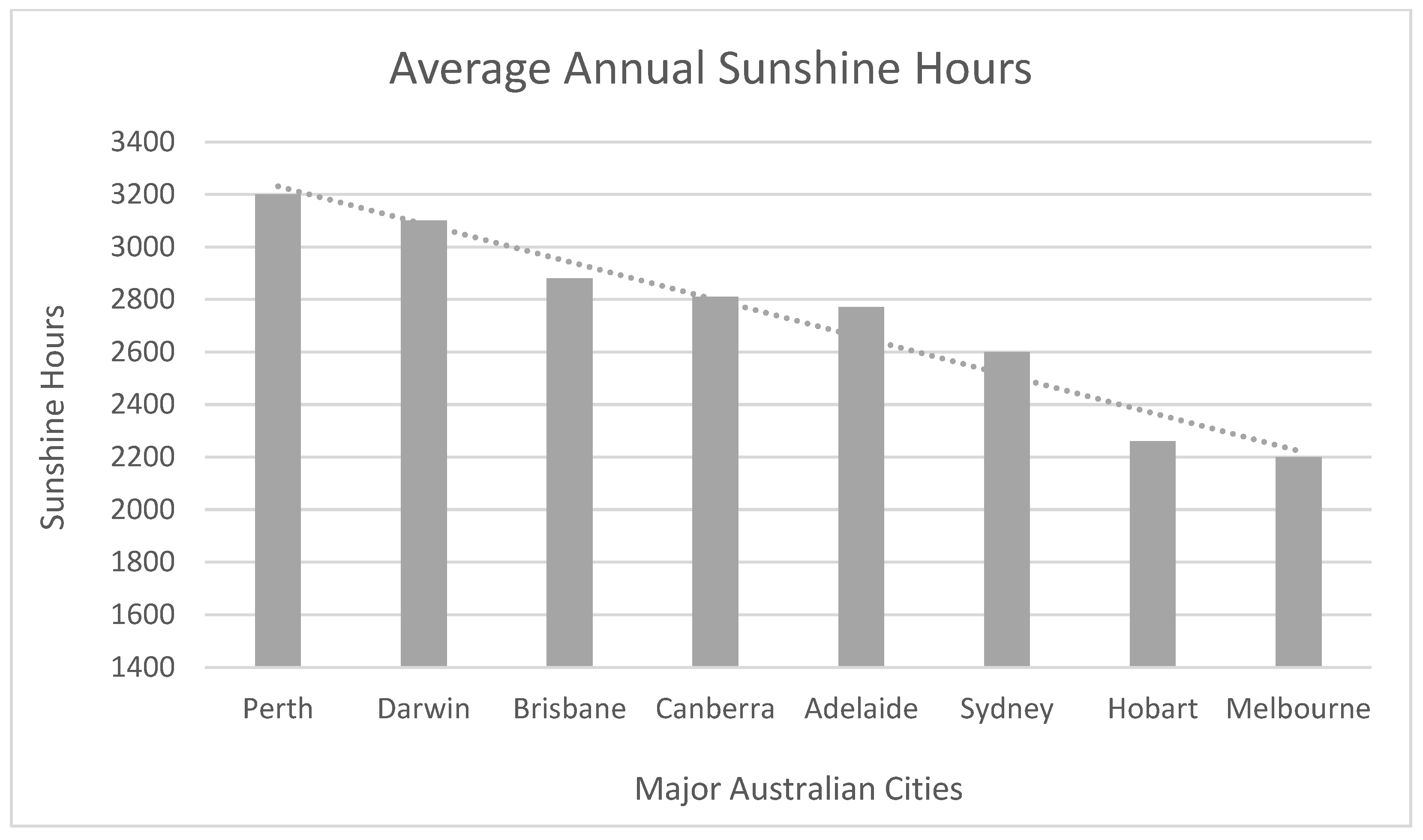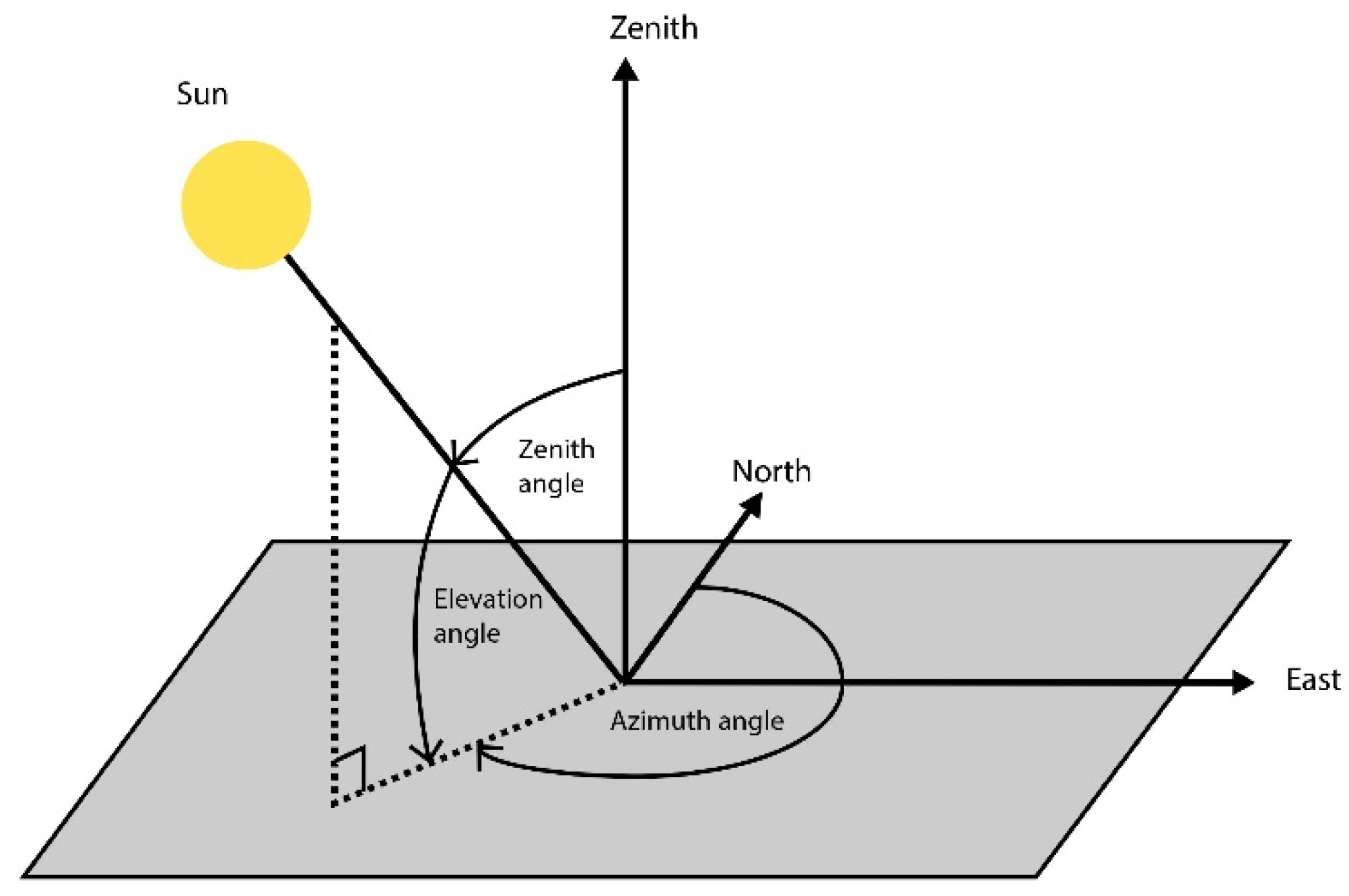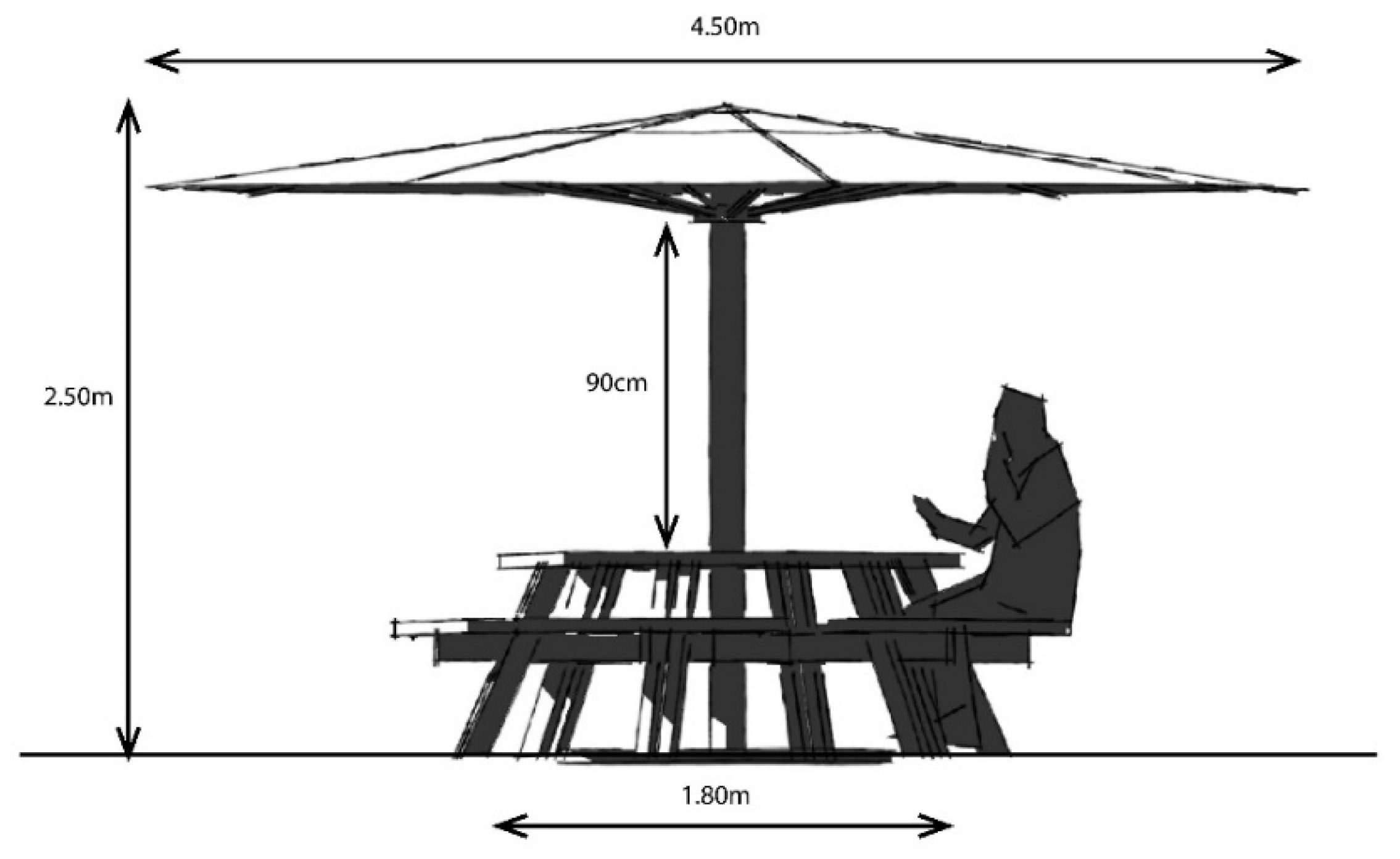Sun-Safe Zones: Investigating Integrated Shading Strategies for Children’s Play Areas in Urban Parks
Abstract
1. Introduction
- (a)
- We conduct a park-usage analysis and shade audit of Beaton Park, Dalkeith, to analyze its shade availability both quantitatively and qualitatively.
- (b)
- We identify the issues in shade quality and propose recommendations for integrated shading strategies, which can offer direction for effective shading of children’s play areas to maximize UVR protection.
Literature Review
2. Materials and Methods
Case Study: Beaton Park, Dalkeith




- Shadow Analysis simulations depicting the average number of hours (per day) in shade.


3. Results
Recommendations
4. Discussion
5. Conclusions
Author Contributions
Funding
Institutional Review Board Statement
Informed Consent Statement
Conflicts of Interest
References
- Australian Institute of Health and Welfare. Skin Cancer in Australia; AIHW: Canberra, Australia, 2016.
- Union for International Cancer Control (UICC). Globocan 2020; UICC: Geneva, Switzerland, 2020. [Google Scholar]
- Gies, P. Australia Has More Than Enough Solar UV Radiation; Taylor & Francis: Abingdon, UK, 2003; Volume 86, pp. 71–73. [Google Scholar]
- Australian Government, Bureau of Meteorology. Average Annual and Monthly Sunshine Duration; Bureau of Meteorology: Canberra, Australia, 2022.
- Gies, P.; Roy, C.; Javorniczky, J.; Henderson, S.; Lemus-Deschamps, L.; Driscoll, C. Global solar UV index: Australian measurements, forecasts and comparison with the UK. Photochem. Photobiol. 2004, 79, 32–39. [Google Scholar] [CrossRef]
- de Gruijl, F.R.; van Kranen, H.J.; Mullenders, L.H. UV-induced DNA damage, repair, mutations and oncogenic pathways in skin cancer. J. Photochem. Photobiol. B Biol. 2001, 63, 19–27. [Google Scholar] [CrossRef]
- Paller, A.S.; Hawk, J.L.; Honig, P.; Giam, Y.C.; Hoath, S.; Mack, M.C.; Stamatas, G.N. New insights about infant and toddler skin: Implications for sun protection. Pediatrics 2011, 128, 92–102. [Google Scholar] [CrossRef]
- Boyle, P.; Maisonneuve, P.; Dore, J. Epidemiology of malignant melanoma. Br. Med. Bull. 1995, 51, 523–547. [Google Scholar] [CrossRef]
- Green, A.C.; Wallingford, S.C.; McBride, P. Childhood exposure to ultraviolet radiation and harmful skin effects: Epidemiological evidence. Prog. Biophys. Mol. Biol. 2011, 107, 349–355. [Google Scholar] [CrossRef]
- Xu, Z.; Etzel, R.A.; Su, H.; Huang, C.; Guo, Y.; Tong, S. Impact of ambient temperature on children’s health: A systematic review. Environ. Res. 2012, 117, 120–131. [Google Scholar] [CrossRef]
- Madden, A.L.; Arora, V.; Holmes, K.; Pfautsch, S. Cool Schools; Western Sydney University: Penrith, Australia, 2018. [Google Scholar]
- The Cancer Council Western Australia Inc. Shade Stories. 2013. Available online: https://www.myuv.com.au/shadestories/shadestories-about/ (accessed on 1 May 2020).
- Olsen, H.; Kennedy, E.; Vanos, J. Shade provision in public playgrounds for thermal safety and sun protection: A case study across 100 play spaces in the United States. Landsc. Urban Plan. 2019, 189, 200–211. [Google Scholar] [CrossRef]
- Holman, D.M.; Kapelos, G.T.; Shoemaker, M.; Watson, M. Shade as an environmental design tool for skin cancer prevention. Am. J. Public Health 2018, 108, 1607–1612. [Google Scholar] [CrossRef]
- Parisi, A.V.; Turnbull, D.J. Shade provision for UV minimization: A review. Photochem. Photobiol. 2014, 90, 479–490. [Google Scholar] [CrossRef]
- Turnbull, D.J.; Parisi, A. Increasing the ultraviolet protection provided by shade structures. J. Photochem. Photobiol. B Biol. 2005, 78, 61–67. [Google Scholar] [CrossRef]
- Schneider, S.; Bolbos, A.; Kadel, P.; Holzwarth, B. Exposed children, protected parents; shade in playgrounds as a previously unstudied intervention field of cancer prevention. Int. J. Environ. Health Res. 2020, 30, 26–37. [Google Scholar] [CrossRef]
- Gage, R.; O’Toole, C.; Robinson, A.; Reeder, A.; Signal, L.; Mackay, C. Wellington playgrounds uncovered: An examination of solar ultraviolet radiation and shade protection in New Zealand. Photochem. Photobiol. 2018, 94, 357–361. [Google Scholar] [CrossRef]
- Miller, W.B.; Akbari, H.; Levinson, R.; Loye, K.; Kriner, S.; Scichili, R.; Desjarlais, A.; Weil, S.; Berdahl, P. Special infrared reflective pigments make a dark roof reflect almost like a white roof. In Thermal Performance of the Exterior Envelopes of Buildings, IX, Proceedings of ASHRAE THERM VIII; American Society of Heating, Refrigerating and Air-Conditioning Engineers (ASHRAE): Peachtree Corners, GA, USA, 2004; Available online: https://coolrooftoolkit.org/knowledgebase/special-infrared-reflective-pigments-make-a-dark-roof-reflect-almost-like-a-white-roof/ (accessed on 5 November 2022).
- Bloch, S. Shade. Places J. 2019. Available online: https://placesjournal.org/author/sam-bloch/ (accessed on 1 May 2020). [CrossRef]
- Vanos, J.K.; Middel, A.; McKercher, G.R.; Kuras, E.R.; Ruddell, B.L. Hot playgrounds and children’s health: A multiscale analysis of surface temperatures in Arizona, USA. Landsc. Urban Plan. 2016, 146, 29–42. [Google Scholar] [CrossRef]
- Soulos, G. The role of shade in skin cancer prevention. N. S. Wales Public Health Bull. 2001, 12, 78–80. [Google Scholar] [CrossRef]
- Pfautsch, S.; Wujeska-Klause, A.; Walters, J. Outdoor playgrounds and climate change: Importance of surface materials and shade to extend play time and prevent burn injuries. Build. Environ. 2022, 223, 109500. [Google Scholar] [CrossRef]
- The Cancer Council Western Australia Inc. Temperature Does Not Determine Risk: Infrared Versus Ultraviolet Radiation; The Cancer Council Western Australia Inc.: Perth, Australia, 2022. [Google Scholar]
- Parsons, P.G.; Neale, R.; Wolski, P.; Green, A. The shady side of solar protection. Med. J. Aust. 1998, 168, 327–330. [Google Scholar] [CrossRef]
- Turnbull, D.J.; Parisi, A.V. Effective shade structures. Med. J. Aust. 2006, 184, 13–15. [Google Scholar] [CrossRef]
- Zarr, R.; Conway, T. What about the Trees? Trees as Nature-Based “Shade Sails”; American Public Health Association: Washington, DC, USA, 2017; Volume 107, pp. 1876–1877. [Google Scholar]
- Brown, R.D.; Vanos, J.; Kenny, N.; Lenzholzer, S. Designing urban parks that ameliorate the effects of climate change. Landsc. Urban Plan. 2015, 138, 118–131. [Google Scholar] [CrossRef]
- Dobbinson, S.; Jamsen, K.; McLeod, K.; White, V.; Wakefield, M.; White, V.; Livingston, P.; Simpson, J.A. Maximising students’ use of purpose-built shade in secondary schools: Quantitative and qualitative results of a built-environment intervention. Health Place 2014, 26, 136–142. [Google Scholar] [CrossRef]
- Mackay, C. Environmental Shade for Protection from UVR; Citeseer: Princeton, NJ, USA, 2009. [Google Scholar]
- Stoneham, M.; Earl, C.; Baldwin, L. Creating Shade at Public Facilities: Policy and Guidelines for Local Government, 2nd ed.; Australian Institute of Environmental Health (AIEH): Brisbane, Australia, 2007; Available online: https://eprints.qut.edu.au/101278/ (accessed on 1 September 2020).
- van Vliet, E.; Dane, G.; Weijs-Perrée, M.; van Leeuwen, E.; van Dinter, M.; van den Berg, P.; Borgers, A.; Chamilothori, K. The Influence of Urban Park Attributes on User Preferences: Evaluation of Virtual Parks in an Online Stated-Choice Experiment. Int. J. Environ. Res. Public Health 2021, 18, 212. [Google Scholar] [CrossRef] [PubMed]
- City of Nedlands. New Name and Now Open: Jo Wheatley All Abilities Play Space Becomes a Reality; City of Nedlands: Nedlands, WA, Australia, 2022. [Google Scholar]
- Centre for the Built Environment and Health. Geo-Spatial Analytic Tool for Public Open Spaces. 2013. Available online: http://www.postool.com.au (accessed on 1 September 2020).
- Weatherzone. Australian Meteorology. 2022. Available online: http://www.meteorology.com.au/local-forecast/wa/dalkeith (accessed on 15 September 2020).
- Fiona Robbé Landscape Architects. Planting Layout Plan; Fiona Robbé Landscape Architects: Arcadia, Australia, 2016. [Google Scholar]
- Urban Forest Ecosystems Institute. SelecTree—A Tree Selection Guide. 2022. Available online: https://selectree.calpoly.edu/ (accessed on 1 October 2020).
- Moogk-Soulis, C. Schoolyard heat islands: A case study in Waterloo, Ontario. In Proceedings of the Canadian Urban Forest Conference, York, ON, Canada, 7–9 October 2002. [Google Scholar]
- Harrington, W.Z.; Strohschein, B.L.; Reedy, D.; Harrington, J.E.; Schiller, W.R. Pavement temperature and burns: Streets of fire. Ann. Emerg. Med. 1995, 26, 563–568. [Google Scholar] [CrossRef] [PubMed]
- Queensland Government. Shade Design Factors to Limit UVR; Department of Health: Brisbane, Australia, 2002. [Google Scholar]
- Austin, G.S. Adobe as a Building Material. New Mex. Geol. 1984, 6, 69–71. [Google Scholar]
- Isenberg, J.P.; Quisenberry, N. Play: Essential for all children. A position paper of the Association for Childhood Education International. Child. Educ. 2002, 79, 33–39. [Google Scholar] [CrossRef]
- Égerházi, L.A.; Kovács, A.; Unger, J. Application of microclimate modelling and onsite survey in planning practice related to an urban micro-environment. Adv. Meteorol. 2013, 2013, 251586. [Google Scholar] [CrossRef]



















| Venue Name | Jo Wheatley All Abilities Play Space (Beaton Park) |
| Area | 2.4 ha |
| Typology | Large neighborhood park |
| Local Government Authority (LGA) | Dalkeith |
| Population density (Belmont) | 14.5 persons/ha. |
| Catchment distance | 800 m |
| Catchment area | 100 ha |
| Catchment population | 1450 persons |
| Mean Minimum Temperature | 8 °C (July/August), 18 °C (February) |
| Mean Maximum Temperature | 17 °C (July), 30 °C (February) |
| Hottest | 43.3 °C (4 February 2020) |
| Coldest | 2.3 °C (19 May 2020) |
| Materials | Reflectivity/Albedo (%) | UVR Absorbed | Ultraviolet Protection Factor (UPF) | |
|---|---|---|---|---|
| % | Protection Score | |||
| Dry sand | 20% | 80% | Low | 5 |
| Grassed lawn | 2% | 98% | Excellent | 50 |
| Shrubs | 1% | 99% | Excellent | 50+ |
| Open water | 5% | 95% | High | 20 |
| Dark concrete | 10% | 90% | Moderate | 10 |
| Light concrete | 15% | 85% | Low | 7.5 |
| Soil/wood mulch | 5% | 95% | High | 20 |
| Timber deck | 5% | 95% | High | 20 |
| Rubber mat | 10% | 90% | Moderate | 10 |
| Stone | 20% | 80% | Low | 5 |
| Asphalt road | 5% | 95% | High | 20 |
| Botanical Name | Common Name | Origin | Foliage | Height at Maturity (m) | Canopy Spread (m) | Time to Maturity (Years) |
|---|---|---|---|---|---|---|
| Agonis flexuosa | West Australian Weeping Peppermint | WA native | Evergreen | 12–15 | 10 | 15–20 |
| Eucalyptus rudis | Flooded Gum | WA native | Evergreen | 10–20 | 8–12 | 10–20 |
| Eucalyptus cornuta | Yate | WA native | Evergreen | 10–20 | 8–12 | 10–20 |
| Eucalyptus leucoxylon | White Ironbark | SA native | Evergreen | 10–27 | 6–18 | 10–27 |
| Eucalyptus camaldulensis | River Red Gum | AUS native | Evergreen | 15–45 | 15–30 | 15–45 |
| Eucalyptus spathulata | Swamp Mallee | WA native | Evergreen | 6–12 | 6 | 10–12 |
| Tamarix aphylla | Salt Cedar | Exotic | Evergreen | 15–18 | 10–15 | 10–20 |
| Melaleuca armillaris | Drooping Melaleuca | AUS native | Evergreen | 5–10 | 5–10 | 5–10 |
| Melaleuca quinquenervia | Paperbark | AUS native | Evergreen | 8–15 | 5–10 | 15–25 |
| Melaleuca nesophila | Pink Melaleuca | WA native | Evergreen | 5–10 | 5–10 | 10–20 |
| Melaleuca squamea | Swamp honey-myrtle | AUS native | Evergreen | 2–6 | 1–3 | 5–10 |
| Melaleuca viminalis | Weeping bottlebrush | AUS native | Evergreen | 10 | 4 | 10–20 |
| Melaleuca linariifolia | Flaxleaf Paperbark | East AUS native | Evergreen | 6–9 | 4–7 | 10–20 |
| Callistemon salignus | White Bottlebrush | AUS native | Evergreen | 7 | 4 | 10–20 |
| Allocasuarina verticillata | Drooping She-oak | AUS native | Evergreen | 6–10 | 6–10 | 20–50 |
| Casuarina equisetifolia | Ironwood | AUS native | Evergreen | 12–20 | 6 | 12–20 |
| Casuarina cunninghamiana | River Oak | AUS native | Evergreen | 20 | 10 | 20–30 |
| Visit | Day/Date | Time | Peak UVI | Temperature (Degrees Celsius) | No. of Users |
|---|---|---|---|---|---|
| 1 | Tuesday, 7 July 2020 | 4:00 pm | 4 at 11:57 am | 17–19 | 18–20 |
| 2 | Tuesday, 29 September 2020 | 4:30 pm | 5.4 at 12:08 pm | 18–20 | 58–60 |
| 3 | Wednesday, 30 September 2020 | 5:30 pm | 4.1 at 1:55 pm | 19–21 | 25–27 |
| Area under Consideration | 2.4 ha |
| Canopy cover | 0.65 ha |
| Canopy percentage | 27% of the total ground cover |
| Percentage of available shade (summer solstice at midday) | 29% of total ground cover |
Disclaimer/Publisher’s Note: The statements, opinions and data contained in all publications are solely those of the individual author(s) and contributor(s) and not of MDPI and/or the editor(s). MDPI and/or the editor(s) disclaim responsibility for any injury to people or property resulting from any ideas, methods, instructions or products referred to in the content. |
© 2022 by the authors. Licensee MDPI, Basel, Switzerland. This article is an open access article distributed under the terms and conditions of the Creative Commons Attribution (CC BY) license (https://creativecommons.org/licenses/by/4.0/).
Share and Cite
Cherian, N.C.; Subasinghe, C. Sun-Safe Zones: Investigating Integrated Shading Strategies for Children’s Play Areas in Urban Parks. Int. J. Environ. Res. Public Health 2023, 20, 114. https://doi.org/10.3390/ijerph20010114
Cherian NC, Subasinghe C. Sun-Safe Zones: Investigating Integrated Shading Strategies for Children’s Play Areas in Urban Parks. International Journal of Environmental Research and Public Health. 2023; 20(1):114. https://doi.org/10.3390/ijerph20010114
Chicago/Turabian StyleCherian, Nikhil C., and Chamila Subasinghe. 2023. "Sun-Safe Zones: Investigating Integrated Shading Strategies for Children’s Play Areas in Urban Parks" International Journal of Environmental Research and Public Health 20, no. 1: 114. https://doi.org/10.3390/ijerph20010114
APA StyleCherian, N. C., & Subasinghe, C. (2023). Sun-Safe Zones: Investigating Integrated Shading Strategies for Children’s Play Areas in Urban Parks. International Journal of Environmental Research and Public Health, 20(1), 114. https://doi.org/10.3390/ijerph20010114






